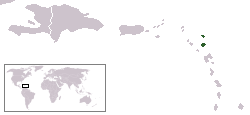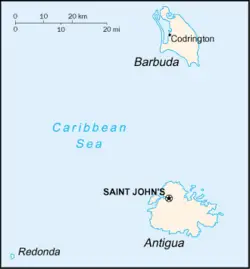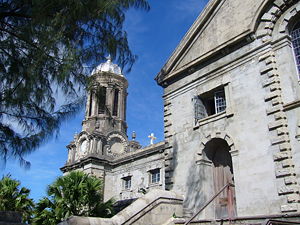Antigua and Barbuda
| Antigua and Barbuda | |||||
| |||||
| Motto: "Each Endeavouring, All Achieving" | |||||
| Anthem: Fair Antigua, We Salute Thee | |||||
| Capital | Saint John's 17°7′N 61°51′W | ||||
|---|---|---|---|---|---|
| Largest city | capital | ||||
| Official languages | English | ||||
| Government | Federal constitutional monarchy | ||||
| - Head of State | Elizabeth II | ||||
| - Governor-General | Louise Lake-Tack | ||||
| - Prime Minister | Baldwin Spencer | ||||
| Independence | from the United Kingdom | ||||
| - Date | November 1, 1981 | ||||
| Area | |||||
| - Total | 442 km² (198th) 171 sq mi | ||||
| - Water (%) | negligible | ||||
| Population | |||||
| - 2005 estimate | 82,786 | ||||
| - Density | 184/km² 394/sq mi | ||||
| GDP (PPP) | 2005 estimate | ||||
| - Total | US$875.8 million | ||||
| - Per capita | US$12,586 | ||||
| HDI (2004) | |||||
| Currency | East Caribbean dollar (XCD)
| ||||
| Time zone | AST (UTC-4) | ||||
| - Summer (DST) | ADT (UTC-3) | ||||
| Internet TLD | .ag | ||||
| Calling code | +268 | ||||
Antigua and Barbuda is an island nation located in the eastern Caribbean Sea on the boundary with the Atlantic Ocean. This country has two major islands: Antigua (IPA: [ænˈtiːgə]) and Barbuda (IPA: [bɑrˈbjuːdə]). They are located in the middle of the Leeward Islands in the Eastern Caribbean, roughly 17 degrees north of the equator. Antigua and Barbuda are part of the Lesser Antilles archipelago with the islands of Guadeloupe, Dominica, Martinique, St. Lucia, St. Vincent & the Grenadines, Barbados, Grenada, Trinidad and Tobago to the south, Montserrat to the southwest, Saint Kitts and Nevis to the west and Saint Barthélemy, Saint Martin and Anguilla to the northwest.
History
Pre-ceramic Amerindians were the first to inhabit the islands of Antigua and Barbuda in 2400 B.C.E. Later Arawak and Carib Amerindian tribes populated the islands. The island of Antigua was named Waladli by these natives and is today called Wadadli by locals. Christopher Columbus landed on his second voyage in 1493 and named the island Santa Maria de la Antigua after a church in Seville, Spain. Early settlement by the Spanish was replaced by English rule from 1632, with a French interlude in 1666. Subsequently Irish Catholic slaves were transported to Antigua [citation needed]. Slavery, established to run the sugar plantations on Antigua, was abolished in 1834.
The islands became an independent state within the Commonwealth of Nations on 1 November 1981, and Vere Bird became the first prime minister.
Politics
The politics of Antigua and Barbuda takes place in a framework of a federal parliamentary representative democratic monarchy, whereby the Prime Minister is the head of government, and of a pluriform multi-party system. Executive power is exercised by the government. A Governor-General is appointed by the Queen (or other reigning monarch). Legislative power is vested in both the government and the two chambers of the Parliament. The bicameral Parliament consists of the Senate (seventeen-member body appointed by the governor general) and the House of Representatives (seventeen seats; members are elected by proportional representation to serve five-year terms). The last elections held were on 23 March 2004 for the House of Representatives; the next are due in 2009. The Antigua Labour Party won four seats, while the United Progressive Party won thirteen.
Government
Since 1949 the party system had been dominated by the personalist Antigua Labour Party. However the Antigua and Barbuda legislative election, 2004, saw the defeat of the longest-serving elected government in the Caribbean. The Prime Minister, Lester Bird, had been in office since 1994, when he succeeded his father, Vere Bird. The elder Bird had been Prime Minister from independence in 1981, and before independence had been Chief Minister of Antigua from 1960, except for the period 1971-76.
Structure
The Head of State is the Queen, who is represented by the Governor-General. A Council of Ministers is appointed by the governor general on the advice of the prime minister. The Judicial Branch is the Eastern Caribbean Supreme Court (based in Saint Lucia; one judge of the Supreme Court is a resident of the islands and presides over the Court of Summary Jurisdiction). Antigua is also a member of the Caribbean Court of Justice. The Supreme Court of Appeal was the British Judicial Committee of the Privy Council, up until 2001, when the nations of the Caribbean Community voted to abolish the right of appeal to the Privy Council in favour of a Caribbean Court of Justice. Some debate between member countries had repeatedly delayed the court's date of inauguration. As of March, 2005, only Barbados was set to replace the process of appeals of Her Majesty in Council with the Caribbean Court of Justice which then had come into operation.
Military
The Royal Antigua and Barbuda Defence Force is a very small military force, with only 170 members.
Parishes and dependencies
The island of Antigua is divided into six parishes:
|
The island of Barbuda (1,241) and the uninhabited island of Redonda each enjoy dependency status.
The capital is the city of St. John's (population 21,514).
Geography
The country consists of a number of islands, of which Antigua is the largest one, and the most populated. Barbuda, just north of Antigua is the other main island. The islands have a warm, tropical climate, with fairly constant temperatures year round. Redonda – annexed in the 1860s when Phosphate reserves were noted, unoccupied since 1930 also belongs to the nation of Antigua and Barbuda.
The islands are mostly low-lying, with the highest point being Boggy Peak, at 402 metres (1,319 ft). The small country's main town is the capital Saint John's on Antigua; Barbuda's largest town is Codrington. Antigua & Barbuda combined have 365 beaches
Economy
Tourism dominates its economy, accounting for more than half of its GDP. Weak tourist arrival numbers since early 2000 have slowed the economy, however, and pressed the government into a tight fiscal corner. The dual-island nation's agricultural production is focused on the domestic market and constrained by a limited water supply and a labour shortage stemming from the lure of higher wages in tourism and construction work.
Manufacturing comprises enclave-type assembly for export with major products being bedding, handicrafts, and electronic components. Prospects for economic growth in the medium term will continue to depend on income growth in the industrialised world, especially in the United States, which accounts for about one-third of all tourist arrivals.
Demographics
The majority of the population is comprised of people of African or mixed African and European (predominately British) ancestry. There is a minority of people of Portuguese and mixed Portuguese and African ancestry, due to Portuguese indentured servants brought to the West Indies after the abolition of slavery. The remainder of the population is comprised of Europeans, notably Irish and British, and Christian Levantine Arabs (primarily of Syrian, Lebanese and Palestinian descent). There is also a small population of Sephardic Jews.
An increasingly large percent of the population live abroad, most notably in the United States, Canada, and England. A minority of the Antiguan residents are immigrants from other countries, particularly Dominica, Guyana and Jamaica. There is also a significant population of American citizens estimated at 4500 people which would make it one of the largest American citizen populations in the English speaking Eastern Caribbean. [1]
Almost all Antiguans are Christians (97%[2]), with the Anglican Church (about 44%) being the largest denomination. Catholicism is the other significant denomination, with the remainder being other Protestants: including Jehovah's Witnesses, Methodists, Moravians, Pentecostals and Seventh-Day Adventists. Non-Christian religions practiced on the islands include Rastafari, Islam, Judaism, and Baha'i.
18.4% of people living in Antigua and Barbuda live below the poverty line. [3]
Language
The official language of Antigua and Barbuda is English, but many of the locals speak Antiguan Creole. The Barbudan accent is slightly different from the Antiguan one. Spanish is also widely spoken in certain communities in Antigua where immigrants from the Dominican Republic make up large numbers.[4]
In the years before Antigua and Barbuda's independence, Standard English was widely spoken in preference to Antiguan Creole, but afterwards Antiguans began treating Antiguan Creole as a respectable aspect of their culture. Generally, the upper and middle classes shun Antiguan Creole. The educational system dissuades use of Antiguan Creole and instruction is done in Standard (British) English. The higher up one goes on the socio economic ladder, the less prevalent Antiguan Creole becomes, to the extent that some Antiguans will even deny that they speak or understand Antiguan Creole
Many of the words used in the Antiguan dialect are derived from English and also African origins. The dialect was formed when en-slaved Africans owned by English planters imitated the 18th century English spoken by their masters; utilizing traditional African language structures they created an African English hybrid or pidgin. This can be easily seen in some phrases like: "Me nah go" meaning "I am not going". Another example is: "Ent it?" meaning "Ain't it?" which is in itself dialect and means "Isn't it?". Common island proverbs often can be traced to Africa.
Culture
An independent scientific study ranked Antiugua and Barbuda as the 16th happiest country in the world.[1] The culture is predominantly British which is evident throughout many aspects of the society. American popular culture also has a heavy influence. Family and religion play an important role in the lives of Antiguans. There is a national Carnival celebration during the month of August each year: historically Carnival commemorates the abolition of slavery in the British West Indies. The annual Carnival includes pageants, shows, contests and festive activities, and is a notable tourist attraction.
Calypso and soca music are important in Antigua and Barbuda, and Burning Flames is a popular band.
Cuisine
The national dish is fungie (pronounced "foon-jee") and pepper pot. Fungie is a dish very similar to the Italian Polenta, and is almost completely made from cornmeal. Other local dishes include ducana, season rice, Saltfish and lobster (from Barbuda). There are also local confectionaries which include: sugarcake, fudge, raspberry and tamarind stew and peanut brittle.
Although these foods are indigenous to Antigua and Barbuda and to some other Caribbean countries, the local diet has diversified and now include the local dishes of Jamaica (e.g. jerk pork), Guyana (e.g. Roti) and other Caribbean countries. Chinese restaurants have also begun to become more mainstream. The supermarkets sell a wide variety of food, from American to Italian. Meals also vary depending on social class.
Lunches here typically include a starch, like rice/macaroni/pasta, vegetables/salad, an entree (fish, chicken, pork, beef etc.) and a side dish like macaroni pie, scalloped potatoes or plantains. Local drinks are mauby, seamoss, tamarind juice, raspberry juice, mango juice, lemonade, coconut milk, hibiscus juice, ginger beer, passion fruit juice, guava juice etc. Adults favor beers and rums, many of which are made locally, including Wadadli beer (named after the original name of the island).
Sunday is the main day most go to church in the country and is the day when the culture is mostly reflected in the food. For breakfast one might have saltfish, eggplant (aka troba), eggs and lettuce.
Dinner on Sundays is eaten earlier (around 2:00 pm) because parents are usually off from work and can stay home and cook. It may include pork, baked chicken, stewed lamb, or turkey, alongside rice (prepared in a variety of ways), macaroni pie, salads, and a local drink. Dessert may be ice cream and cake or an apple pie (mango and pineapple pie in their season) or Jello.
Media
There are two daily newspapers: Daily Observer, and Antigua Sun which also publishes newspapers on other Caribbean islands. Most American television networks are available in addition to the local television stations. There are several local and regional radio stations.
Sport
Cricket is very popular in Antigua and Barbuda, along with most Commonwealth nations. The 2007 Cricket World Cup was hosted in the West Indies from 11 March to 28 April 2007. Antigua hosted eight matches at the Sir Vivian Richards Stadium, which was handed over by the Chinese Government on 11 February 2007, and holds 20,000 people at full capacity. Antigua is also the Host of 20/20 Cricket created by Allen Stanford in 2006 a regional cricket game with almost all caribbean islands taking part. Next 20/20 will be in November 07.
Football (soccer) is also a very popular sport. Antigua has a national football team, albeit inexperienced.
Athletics is also big in Antigua. Talented athletes identified in schools are trained from a young age and Antigua has produced one or two fairly adept athletes. Janill Williams, a young athlete with much promise hails from Gray's Farm, Antigua. Also, there is Sonia Williams and Heather Samuel who have represented Antigua at the Olympic Games. Others to watch are Brendan Christian (100 m, 200 m), Daniel Bailey (100 m, 200 m) and James Grayman (High Jump).
Education
The people of Antigua & Barbuda have a high level of education with over 90% of the people being literate. In 1998, Antigua adopted a national mandate to become the preeminent provider of medical services in the Caribbean. As part of this mission, Antigua is building the most technologically advanced hospital in the Caribbean, the Mt. St. John Medical Centre. The island of Antigua currently has two medical schools: American University of Antigua College of Medicine (AUA)[5], founded in 2004 and The University of Health Sciences Antigua (UHSA)[6], founded in 1982.
There is also a government owned state college in Antigua as well as the Antigua and Barbuda Institute of Information Technology (ABIIT). The University of the West Indies has a branch in Antigua for locals to continue University studies.
With the onset of the Internet, more Antiguans are completing online degrees.
Facts
- The Antigua Racer Snake is the rarest snake in the world, with only about two hundred living. It is found on Bird Island, an island off the coast of Antigua.
- Vere Cornwall Bird, Antigua and Barbuda's first Prime Minister, is accredited to have brought Antigua and Barbuda and the Caribbean into a new era of independence.
Foreign relations
Antigua and Barbuda is a member of the United Nations, the Commonwealth of Nations, Caribbean Community, Organisation of Eastern Caribbean States, Organization of American States, World Trade Organization and the Eastern Caribbean's Regional Security System.
Antigua and Barbuda is also a member of the International Criminal Court (with a Bilateral Immunity Agreement of protection for the US-military as covered under Article 98).
See also
|
|
|
|
ReferencesISBN links support NWE through referral fees
- CIA World Factbook entry on Antigua and Barbuda
External links
- The Official Website of the Government of Antigua and Barbuda
- Antigua & Barbuda, its Department of Tourism website
- Antigua and Barbuda, United States Library of Congress Portals on the World
- Governments on the WWW: Antigua and Barbuda
- The High Commission of Antigua and Barbuda. Tourism, business, history and culture, politics - an up to date website.
- Antigua Carnival - with photo galleries.
- American University of Antigua - a hospital integrated medical scool in Caribbean.
- Health Sciences library - Library of American University of Antigua
| Countries and territories of the Caribbean | |||||||||||||||||||||
|---|---|---|---|---|---|---|---|---|---|---|---|---|---|---|---|---|---|---|---|---|---|
| |||||||||||||||||||||
| Countries of North America | |||
|---|---|---|---|
| Sovereign states | Antigua and Barbuda · Bahamas · Barbados · Belize · Canada · Costa Rica · Cuba · Dominica · Dominican Republic · El Salvador · Grenada · Guatemala · Haiti · Honduras · Jamaica · Mexico · Nicaragua · Panama · St. Kitts and Nevis · St. Lucia · St. Vincent and the Grenadines · Trinidad and Tobago · United States | ||
| Dependencies |
| ||
Credits
New World Encyclopedia writers and editors rewrote and completed the Wikipedia article in accordance with New World Encyclopedia standards. This article abides by terms of the Creative Commons CC-by-sa 3.0 License (CC-by-sa), which may be used and disseminated with proper attribution. Credit is due under the terms of this license that can reference both the New World Encyclopedia contributors and the selfless volunteer contributors of the Wikimedia Foundation. To cite this article click here for a list of acceptable citing formats.The history of earlier contributions by wikipedians is accessible to researchers here:
The history of this article since it was imported to New World Encyclopedia:
Note: Some restrictions may apply to use of individual images which are separately licensed.
- ↑ Human Development Report. United Nations Development Programme. Retrieved 2007-06-15.




